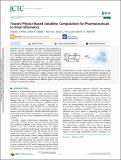Files in this item
Toward physics-based solubility computation for pharmaceuticals to rival informatics
Item metadata
| dc.contributor.author | Fowles, Daniel J. | |
| dc.contributor.author | Palmer, David S. | |
| dc.contributor.author | Guo, Rui | |
| dc.contributor.author | Price, Sarah L. | |
| dc.contributor.author | Mitchell, John B. O. | |
| dc.date.accessioned | 2021-05-25T09:30:01Z | |
| dc.date.available | 2021-05-25T09:30:01Z | |
| dc.date.issued | 2021-06-08 | |
| dc.identifier | 274343482 | |
| dc.identifier | 118e9be9-105c-49a2-8c24-3cdabe7e8f94 | |
| dc.identifier | 85106459352 | |
| dc.identifier | 000661542700037 | |
| dc.identifier.citation | Fowles , D J , Palmer , D S , Guo , R , Price , S L & Mitchell , J B O 2021 , ' Toward physics-based solubility computation for pharmaceuticals to rival informatics ' , Journal of Chemical Theory and Computation , vol. 17 , no. 6 , pp. 3700-3709 . https://doi.org/10.1021/acs.jctc.1c00130 | en |
| dc.identifier.issn | 1549-9618 | |
| dc.identifier.other | Jisc: 3a1140f9a97f4314a0f78347ab537b12 | |
| dc.identifier.other | ORCID: /0000-0002-0379-6097/work/94669110 | |
| dc.identifier.uri | https://hdl.handle.net/10023/23246 | |
| dc.description | D.S.P. and D.J.F. thank the EPSRC for funding via Prosperity Partnership EP/S035990/1. D.S.P. and D.J.F. thank the ARCHIE-WeSt High-Performance Computing Centre (www.archie-west.ac.uk) for computational resources. The UCL authors thank Prof. Keith Refson for guidance with the phonon calculations, which used the ARCHER U.K. National Supercomputing Service (http://www.archer.ac.uk) as part of the U.K. HEC Materials Chemistry Consortium, which is funded by the EPSRC (EP/L000202, EP/R029431). R.G. was funded by MagnaPharm, a project funded by the European Union’s Horizon 2020 Research and Innovation programme under grant agreement number 736899. | en |
| dc.description.abstract | We demonstrate that physics-based calculations of intrinsic aqueous solubility can rival cheminformatics-based machine learning predictions. A proof-of-concept was developed for a physics-based approach via a sublimation thermodynamic cycle, building upon previous work that relied upon several thermodynamic approximations, notably the 2RT approximation, and limited conformational sampling. Here, we apply improvements to our sublimation free-energy model with the use of crystal phonon mode calculations to capture the contributions of the vibrational modes of the crystal. Including these improvements with lattice energies computed using the model-potential-based Ψmol method leads to accurate estimates of sublimation free energy. Combining these with hydration free energies obtained from either molecular dynamics free-energy perturbation simulations or density functional theory calculations, solubilities comparable to both experiment and informatics predictions are obtained. The application to coronene, succinic acid, and the pharmaceutical desloratadine shows how the methods must be adapted for the adoption of different conformations in different phases. The approach has the flexibility to extend to applications that cannot be covered by informatics methods. | |
| dc.format.extent | 10 | |
| dc.format.extent | 4493821 | |
| dc.language.iso | eng | |
| dc.relation.ispartof | Journal of Chemical Theory and Computation | en |
| dc.subject | QD Chemistry | en |
| dc.subject | NDAS | en |
| dc.subject.lcc | QD | en |
| dc.title | Toward physics-based solubility computation for pharmaceuticals to rival informatics | en |
| dc.type | Journal article | en |
| dc.contributor.institution | University of St Andrews. EaSTCHEM | en |
| dc.contributor.institution | University of St Andrews. School of Chemistry | en |
| dc.contributor.institution | University of St Andrews. Biomedical Sciences Research Complex | en |
| dc.identifier.doi | https://doi.org/10.1021/acs.jctc.1c00130 | |
| dc.description.status | Peer reviewed | en |
This item appears in the following Collection(s)
Items in the St Andrews Research Repository are protected by copyright, with all rights reserved, unless otherwise indicated.

